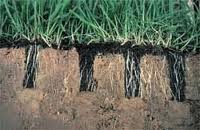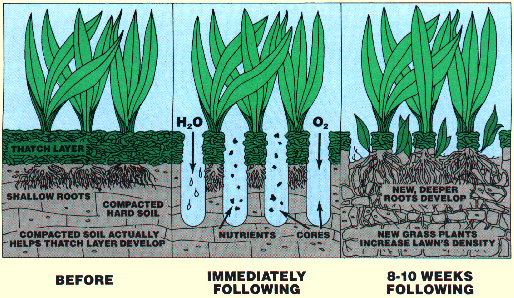Core-aeration is the process of mechanically shattering the soil with half to one inch hollow tubes. These tubes, or tines penetrate 2 ½ in ches or more, remove a core of thatch and soil, then re-deposit the soil onto the lawn. Core-aeration may produce as few as two holes per square foot of turf or more than six holes per square foot of turf depending on desired results. Core-aeration should only be performed when the grass plants are actively growing. ches or more, remove a core of thatch and soil, then re-deposit the soil onto the lawn. Core-aeration may produce as few as two holes per square foot of turf or more than six holes per square foot of turf depending on desired results. Core-aeration should only be performed when the grass plants are actively growing.
Core-aeration has been used since as early as 1930 to relieve compacted soil or aid in the addition of soil amendments such as sand or organic matter. Today on the home lawn, in addition to relieving compaction, we use core-aeration to help reduce thatch levels and increase rooting of grass plants. Heavy thatch and compacted soil prevent air, water and nutrients from reaching the root zone. Under the condition of heavy thatch and compacted soil, despite adequate water and fertilization, a lawn remains lack luster in appearance.
Thatch is a build up of rhizomes and stolons between the crown of the plant and the root zone. Clippings from regular lawn mowing do not contribute to thatch build up. Blue grass lawns nurtured by abundant sunlight, moisture, and fertilization, will develop thatch. A half inch of thatch or less is good and contributes to the soil environment. More than a half inch of thatch tends to become hydrophobic, actually repelling water and nutrients needed in the root zone. Heavy thatch is also a breeding ground for detrimental insects such as chinch bugs and sod web worms.
Earthworms are the first and best line of defense against exorbitant thatch build up. Proper soil pH, use of earthworm friendly pesticides, and returning clippings to the soil are three ways to enhance earthworm activity. Core-aeration performed in a manner where the soil cores are used as a top dressing on the lawn also is used to maintain satisfactory thatch levels.
Soil Compaction occurs over time as the weight of lawn equipment and foot traffic presses down on the soil. Moist conditions increase the rate at which soil becomes compacted. Earthworms work silently and constantly tilling the soil beneath our feet thereby reducing compaction naturally. Regular core-aeration enhances the environment for the earthworm in addition to mechanically relieving soil compaction.
Core-aeration stimulates root growth. Studies show that the hole created by core aeration is quickly filled by new grass roots eager to take advantage of the increased air, water, and nutrients in that area. In blue grass lawns new grass plants are created by core-aeration as well.
Over seeding is usually performed in conjunction with core-aeration as part of an ongoing lawn rejuvenation program.

The benefits of core-aeration are many. An immediate infusion of water, and nutrients top the list. By increasing air movement in the soil we decrease fungus activity, decrease soil compaction and stimulate root growth. Core-aeration increase the all important seed to soil contact in over seeding operations. Core-aeration incorporates organic matter into the soil improving tillage as well as drainage. The cores when dispersed over the lawn as top dressing aid in the long term control of thatch levels. I have also used core-aeration to even out horse's hoof marks in the lawn.
Core-aeration is the least labor intensive, most environmentally friendly gift we can give our lawn. Whereever possible, core-aerate the home lawn once every fall. Core-aeration should be performed at a minimum of three year spans on lawns maintained under a regular fertilization program. Spring core-aeration is fine, but lacks the punch of a fall core-aeration. Theoretically spring core aeration will not affect crabgrass pre-emergent. Combined with over seeding, a fall core-aeration is pure dynamite.
If you have been blessed with the stewardship of a lawn, remember the importance of that task. The average size healthy lawn cleans the air and produces enough oxygen for two families of four. When the temperature of pavement hits 100 degrees F, the temperature on turfgrass areas is about 75 degrees F, cooling the environment. Turfgrass reduces noise by absorbing, deflecting, and refracting sound. Turfgrass holds topsoil in place, cleans rain water, and cleans the air we breath. |